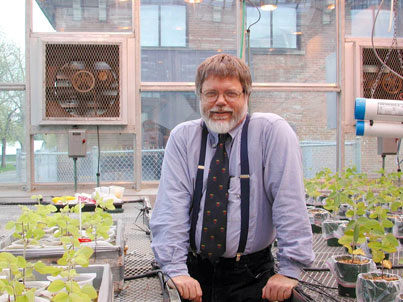Sowing the seeds of World Wide Wisdom
Sowing the seeds of World Wide Wisdom McGill University
User Tools (skip):

Don Smith at the research greenhouse at Macdonald campus.
Fazli Mabood
Sowing the seeds of World Wide Wisdom
It is afternoon one day in early spring and Don Smith has been outside inspecting his garden. "The tulips are coming up," he says over the phone. "My favorite flowers are the snowdrops because they're tough as nails. They started coming out in February, right through the snow. They give me hope."
But in a world teetering on the environmental precipice, the James McGill Professor and Chair in the Department of Plant Science knows that hope alone just won't cut it.
Enter the Green Crop Network (GCN)—a network of leading scientists from across Canada conducting innovative research to develop crops that reduce carbon dioxide (CO2) and nitrous oxide (N2O), look at the effects of growing CO2 levels from fossil fuels on major crop species, and create new plants whose conversion to biofuels requires less fossil fuel. Smith is scientific director.
Funded by an NSERC research grant of $2 million a year for the next five years, the GCN has at its disposal the world-class expertise of 50 renowned Canadian scientists and more than 40 graduate students in 14 universities across Canada.
In the fall of 2006, Smith started working in conjunction with Bert Drake, senior scientist of the Smithsonian Environmental research Center in Washington DC, to develop a graduate course that could be offered across the web to the students of the GCN.
Course material and professorial expertise were not an issue. Delivering the goods to students was another story. Traditional videoconferencing technology would require participants to relocate to venues equipped with specialized hardware.
But sometimes hope, and a bit of good timing, go a long way. When Smith approached the people at Instructional Multimedia Services (IMS) for advice, he found they were preparing to buy the dedicated Marratech software designed especially for facilitating lectures and meetings over the web.
"Once IMS installed it on the server, we became the test case for McGill," said Smith. All participants needed was a PC or laptop with a camera and a microphone and they could log in for the live lectures.
Enlisting a small group of seven students ("people who don't mind the bumps because they think what we are doing is neat.") scattered across Canada from UBC to Saint Mary's, the first course in mid-January was a success. Traveling in India at the time, Smith logged on at 1:30 a.m., further proof of the capability of distance education.
Over the course of the semester, students took in lectures and delivered presentations of their own—all done remotely.
For Smith, the advantages are obvious. "Rather than a single professor trying to teach such a broad topic, we had the very best people in North America giving lectures on their area of expertise," he said.
Of course, distance education also brings up the issue of the future of brick and mortar institutions like McGill.
"I think this technology will work really well for grad students—who tend not to come out of their labs that often anyway—and for bringing in guest lecturers," said Smith. "But undergrads need the social environment as well because they are learning more than just what comes out of books. They are still young enough that they need some sort of human contact with their professors."

